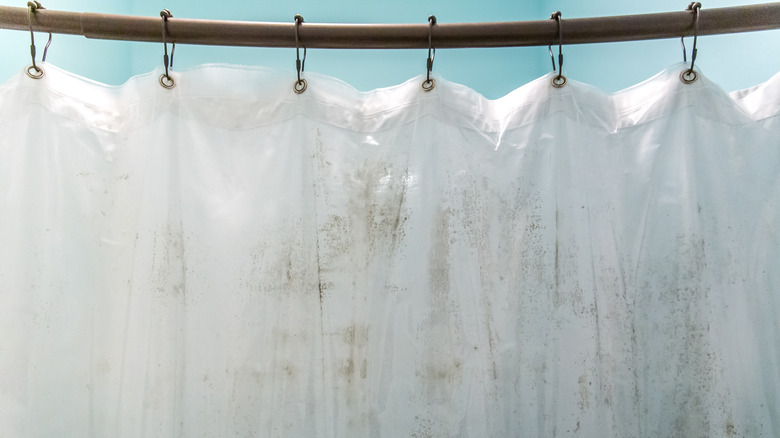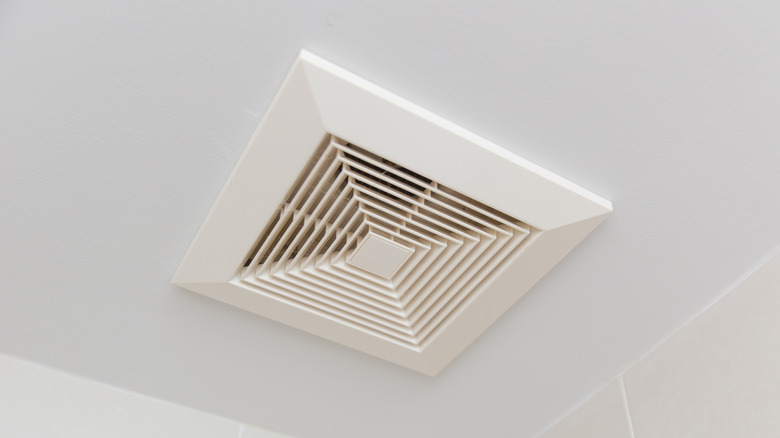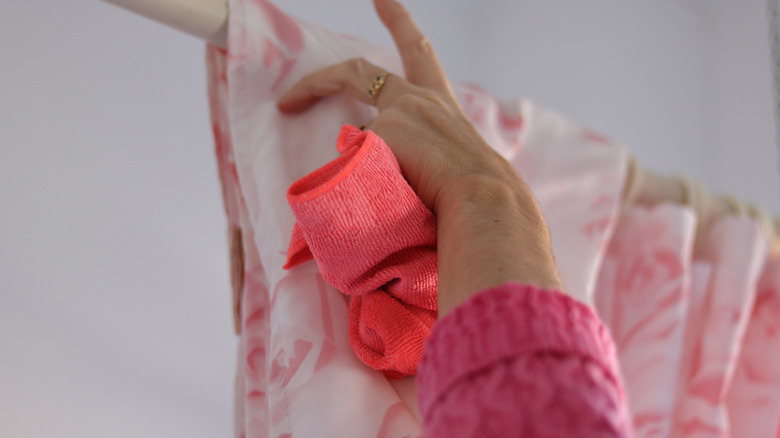How To Clean Mildew Buildup On Your Shower Curtain
Whether you're a lover of steamy hot showers or are rejuvenated by a dose of cold water on your body, those daily washes could be the start of a major mildew problem. Mold and mildew buildup can show even if you laugh in the face of grime and gunk and keep your bathroom in tip-top shape. While cleaning your sinks, toilet, bath, and shower may seem like a no-brainer, it's your shower curtain that might not get the disinfecting it deserves.
Mildew, just like mold, thrives in moist environments, and your shower curtain is a perfect breeding ground for harmful fungi. Unlike mold, which is recognized by its black spots or "fuzzy" appearance, mildew forms an almost chalky substance that tends to spread externally, per The Spruce. So what you might think is just harmless soap-scum buildup on your shower curtain might actually be mildew starting to spread.
Regardless of whether you have a plastic liner or a machine washable shower curtain, without proper cleaning, that mildew could become a real problem. But before you just toss out your existing shower curtain or make the same mistake with a new purchase, here are a few tips to clean that pesky mildew.
Ways to stop the spread of mildew
The first step to take in order to stop the spread of mildew is to get rid of the moisture in your bathroom. Although this may seem a little daunting — because, let's face it, your bathroom is a haven of water — it's actually super simple. The easiest way to give moisture a chance to escape is to keep a window open during and after your shower. The United States Environmental Protection Agency also recommended using dehumidifiers and ceiling exhaust fans in your bathroom to help reduce the amount of moisture that remains after you bathe.
Other tricks to stop moisture from settling on your shower curtain is to make sure to pull it closed after you're done. This will increase the surface area and allow it to dry quicker. If you keep your liner closed after a bath or shower, then condensation may collect in the folds of your curtain and give mildew a chance to grow.
These steps can help decrease the chance of harmful mildew from starting or spreading, but what if the problem is already there?
Helpful tips to get rid of mildew
If mildew has already reared its ugly head, there are a few easy ways to get rid of that nasty buildup before you just throw your shower curtain in the trash. First, check the cleaning label on your fabric, plastic, or vinyl curtain to see if it's machine washable. Sometimes it could just be a matter of tossing your curtain in for a quick wash cycle to eliminate the fungi. Make sure that you hang dry your plastic or vinyl liners before putting them back in your bathroom. Although these liners may be safe for your washing machine, that doesn't necessarily mean that they should be placed in your dryer.
If you want to tackle that mildew by hand with some household ingredients, then Reader's Digest suggested some helpful methods. Soak your shower curtain for under fifteen minutes in a solution containing equal parts vinegar and borax with added water. Then grab a sponge and work it in to try and scrub away the mildew before rinsing it and hanging it to dry. You could also add a little dish soap to some bleach and keep it in a spray bottle to make a handy cleaning mixture. Also, if you're looking for a more natural way of keeping mildew at bay, then vinegar and baking soda offer some of the same results as chemical household cleaners without the harmful fumes, according to Healthline.


